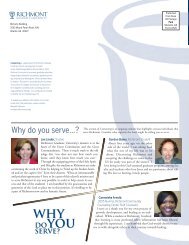Richmont_Fall 2012:PSI newsletterFall06.qxd - Richmont Graduate ...
Richmont_Fall 2012:PSI newsletterFall06.qxd - Richmont Graduate ...
Richmont_Fall 2012:PSI newsletterFall06.qxd - Richmont Graduate ...
- No tags were found...
You also want an ePaper? Increase the reach of your titles
YUMPU automatically turns print PDFs into web optimized ePapers that Google loves.
Page 8Seeing the Face of Christ in OthersWILLIAM F. DOVERSPIKE, PH.D.About 20 years ago, when I was on a weekendretreat at a monastery out in the middle ofnowhere, I took an afternoon walk and wasapproached by a stranger. With someexcitement in her voice, she told me that shehad just seen the face of Jesus in the bark of atree in a nearby forest. With some cynicism, Itold her that I couldn’t even see the face of Jesusin the people with whom I worked eachweek—much less on the side of a pine tree.Later that afternoon, however, I did see the faceof Christ in a stained glass window of the abbeywhere I was staying. It was just a coincidence—God’s way of remaining anonymous. I laterlearned that the artist, who just happened to bea close friend of my spiritual advisor at thetime, had designed the window so that the facewas discernible only at a certain distance. If onewere too far away—or too close—the imagecouldn’t been seen at all.Ten years later, back in the real world where Iwas practicing psychotherapy and teachingethics seminars, I accepted an offer to teach myfirst class in a Christian counselor trainingprogram. I came to <strong>Richmont</strong> because Ithought I would enjoy the challenge ofteaching ethics in a Christian counselingprogram. I have stayed at <strong>Richmont</strong> becausemy life has been transformed by you. When Ithink of the relationship I’ve had with you, Iam reminded of all the pieces of the mosaicthat comprised the stained glass windowdepicting the face of Christ that I saw at thatmonastery 20 years ago. Each one of you is likea brightly colored piece of an intricate design.Yet, the image of Christ becomes clear onlywhen I stand back in contemplation and seethe picture as a whole. From this perspective, Isee not only the image of the face of Christ, butthrough that image I see the faces of the peoplewhose lives are transforming others.Some of you are the eyes of Christ, seeing inothers not only what they see in themselves,but also seeing what they do not see inthemselves. You see the message as well as themess. In other words, you not only see wherethey have been; you see where they are capableof being. And in doing so, you help othersbecome what they are meant to be—helpingthem become what they were created to be. LetGod use your eyes to see others, because it is inyour vision of their potential that you helpbring about a transformation that is beyondanything they can see when they first begintheir journeys with you.Counseling Tip #1: See in others whatthey can be, and you help them becomewhat they are capable of being. 1Some of you are the ears of Christ, listening inmeasured silence, not only to what is said, butalso to how is it said. You listen to the music aswell as the lyrics of the song. In other words,you listen not only to what is said, but also towhat is not said. And in doing so, you helpothers hear what is in between the line—helping them hear what they do not hearthemselves saying. Let God use your ears tolisten to others, because it is in your listening tothe sacred spaces of silence that healing occurs. 2Counseling Tip #2: When you don’tknow what to say, count to 100. Whenyou do know what to say, count to 1,000.Some of you are the mouth of Christ, speakingnot only the right word at the right time withthe right balance of mercy and justice, but alsoknowing when not to speak. You speak the realas well as the ideal. In other words, you knowwhen to say something; you know when to saynothing. And in doing so, you help others hearthe hidden voice that resides within—helpingthem learn not only what they may be doingwrong, but—more importantly—what they aredoing right. Let God use your words to touchothers, because it is in the compassionate,caring reflection that transformations occur.Counseling Tip #3: Remember that mostpeople will not care how much you know somuch as they will know how much you care.I encourage you to base your treatment planson scientific empiricism and evidenced-basedprinciples. At the same time, I encourage youto envision goals that are attainable onlythrough Divine intervention. Expectmiracles—because you will be witnesses totransformations that are beyond what othersexpect for themselves at the time of their firstmeeting with you. Miracles rarely happeninstantaneously; they usually take time—andtime is God’s way of keeping everything fromhappening at once. 3That last statement is often attributed to AlbertEinstein, although the quote is actually takenfrom science fiction writer Ray Cummings, whowrote the 1921 novel, The Time Professor. AlbertEinstein did say, however, that the significantproblems we face cannot be solved by the sametype of thinking that created them. 4 I say to you:Change your thinking and you change your life.As I see it, our thoughts become our actions, ouractions become our habits, our habits becomeour character, and our character becomes ourdestiny. In other words, we change ourthinking and we change our destiny.Counseling Tip #4: Don’t try to changeothers; strive to change yourself. Don’t tryto judge others; strive to accept them—and they will become changed.In my charge to you, professional counselors, Ihave found you to be fully charged, completelyelectrifying, powerful transformers of humanlives. In my charge to you, Christiancounselors, I encourage you to see the face ofChrist in those you serve. In other words, Ichallenge you to be who you already are:You are visionaries. You are the eyes of Christ,as you see in your clients the unlimitedpotential that they do not see in themselves.You are witnesses. You are the ears of Christ, asyour clients’ confessions of themselves asbroken beings are transformed beyond anyvision they can imagine when they first begintheir journeys with you.You are role models. You are the mouth ofChrist, not a critical frown, but a loving smile---nurturing, supporting, and encouraging thetransformation of others into whom they werecreated to be.Finally—and most importantly—I challengeyou to let others experience with you thetransformation that I have experienced withyou. Let others see in you what I have seen inyou—the Face of Christ—a window throughwhich we gain a glimpse of God.Adapted from Dr. Doverspike’s Charge to the graduating Class of <strong>2012</strong>.1. Original text: “Wenn wir Mann behandeln, während er ist, bilden wir ihn schlechter,als er ist. Aber, wenn wir einen Mann behandeln, wie er sein soll, lassen wir ihnwerden, was er zum Sein fähig ist [Transliteration: “When we treat man as he is, wemake him worse than he is. But when we treat a man as he ought to be, we make himbecome what he is capable of being.”] Modern translation: “Treat others as if theywere what they ought to be, and you help them to become what they are capable ofbeing.” Johann Wolfgang von Goethe (1749-1832)2. Plouffe, Mary (Clinical Psychologist in South Freeport, Maine). (2011). In silence thereis healing. This I believe: A public dialogue about belief—one essay at a time. The BobEdwards Show. April 8, 2011. Retrieved http://thisibelieve.org/essay/28381/3. Although often attributed to Albert Einstein, the quote is actually from RaymondKing Cummings, a science fiction writer who in 1922 wrote “Time... is what keepseverything from happening at once.” Cummings, R. K. (1922). The Girl in theGolden Atom. Lincoln, NE: University of Nebraska Press. p. 46. Cummings repeatedthis sentence in several of his novellas. Some sources attribute the quote to his earlierwork, The Time Professor, in 1921.4. Calaprice, Alice. (Ed.) (2005). The New Quotable Einstein. Princeton, NJ: PrincetonUniversity Press. Alice Calaprice reports that she could not find sources for twoquotes often attributed to Albert Einstein in 1946: “The significant problems we facecannot be solved at the same level of thinking we were at when we created them” and“The world we have created today as a result of our thinking thus far has problemswhich cannot be solved by thinking the way we thought when we created them.” Itis possible that both may be paraphrases of Einstein’s statements made in 1946: “Anew type of thinking is essential if mankind is to survive and move toward higherlevels” from “Atomic Education Urged by Einstein” in New York Times (May 25,1946) and later quoted in the article “The Real Problem is in the Hearts of Man” byMichael Amrine, from the New York Times Magazine (June 23, 1946).





